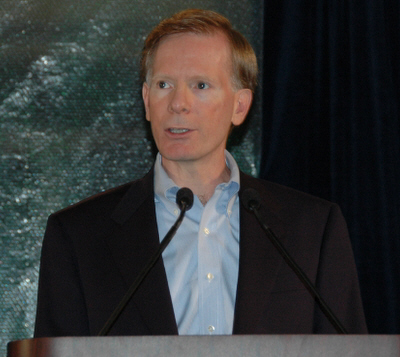Friction in the flat world

I attended the UPS Technology Summit in Louisville, KY, today, moderating a panel on the technological challenges in going global. UPS has invested billions over its 99-year history in optimizing the movement of material goods around the world. The company delivers nearly 15 million packages and documents per day, operates in more than 200 countries and territories and has over 407,000 employees (closer to 500,000 during the Christmas season). UPS claims that it handles 2 percent of global GDP and 6 percent of U.S. GDP.
UPS has developed sophisticated internal systems as well as shipping and supply chain management applications, ranging from CampusShip, a self-service, UPS hosted, Web-based shipping application, to Flex Global View, which manages and provides visibility into air, ocean, ground and rail freight and UPS small package transportation, and TradeSense, a software suite for automating import-export transactions.
UPS CIO Dave Barnes (pictured below) opened the event with a nod to Tom Friedman’s articulation of the flattening world of communications commerce, noting that 95 percent of consumers are outside of the U.S. He also linked corporate survival to effectively innovating and adapting around multinational supply chains in the service of global trading. Companies that fail to have a growth strategy, especially in the flattened world, and a focus on operational efficiency and synchronizing commerce across goods, funds and information, will end up trailing competitors. “Supply chains are competing against supply chains,” Barnes said.

While UPS has set a standard for its part in supply chain management scenarios, most enterprises could not be classified as operationally efficient. One major issue, according to Barnes, is that most supply chains are incapable of handling emergencies or crises. Dwight Klappich, a research vice president at Gartner, described global supply chains as increasingly “complex, chaotic and inherently unstable.” The world is flat, but the global movement of goods in the beginning of the 21st century is full of friction and risk.
According to Beth Enslow, a senior vice president at Aberdeen Group, only 11 percent of respondents in an Aberdeen survey of 650 companies said they were actively managing risk. Another major problem is the growing complexity and a lack of visibility into supply chains. A quarter of respondents in the survey cited spreadsheets as their main supply chain management tool and only 6 percent were highly automated.
James Rice, who is director of the Integrated Supply Chain Management Program at the Center for Transportation and Logistics at MIT, also identified complexity—increasing distances and dependence on trans-border flows—as a major industry challenge. Global supply chains are becoming more fragile and material flows are more vulnerable to attacks, he said. He cited five key technology challenges:
- Interoperability between disparate systems—data sharing, synchronization and regional solutions
- Electronic communication across global supply networks—visibility across decentralized systems
- Data utilization and analysis in the face of a tsunami of data
- Integrating security into systems to facilitate a secure, end-to-end chain of custody
Making the business case clear for investing in the latest global supply chain and trading solutions is also a challenge. Management needs to see a clear ROI justification. "The real issue is what business process changes can drive value," Barnes said. Some of the benefits are obvious, such as improving margins, but others are less apparent until a company has been slapped with fines for some trade violation. Brad Menard, director of customs and logistics at Fossil, has come up with manual solutions for some trading problems, such as dealing with exotic leathers that require special permits for import and export, and has looked to outsource some of the elements in moving goods through his company’s supply chain.
Barnes talks about reducing complexity and moving supply chains from operational efficiency to a "customer intimacy" stage. The goal is to take friction and inflexibility out of global trading and to expose all the levers that can lead to more value for the company and customers. For that to come to pass, a lot of heavy lifting is ahead. It's one thing for UPS to optimize its part of the global supply chain puzzle, and another for all the other pieces, including governments, to create a systems that operate as easily as the global ATM banking system.